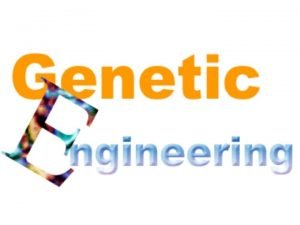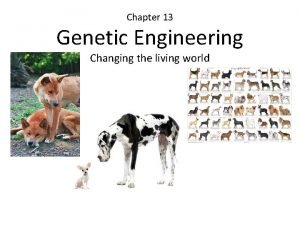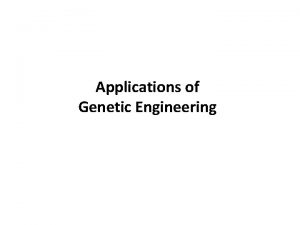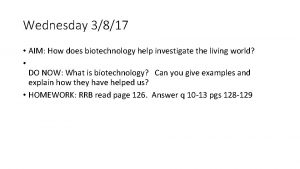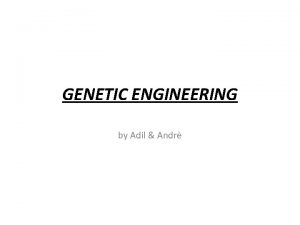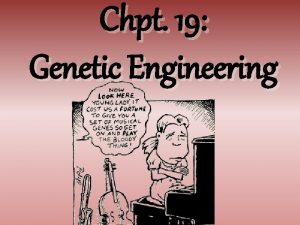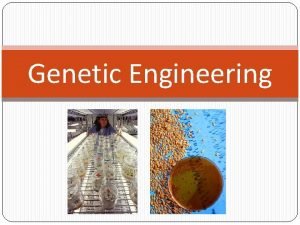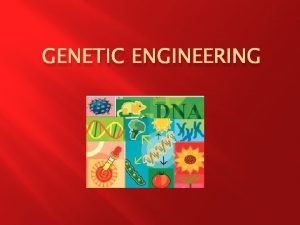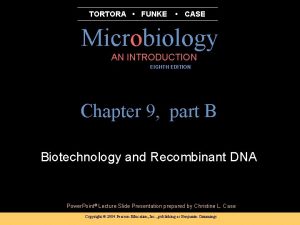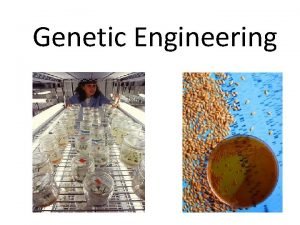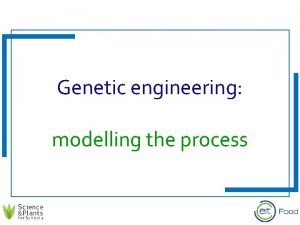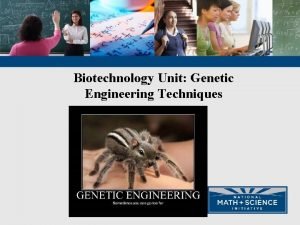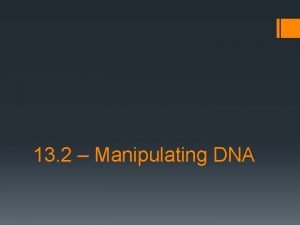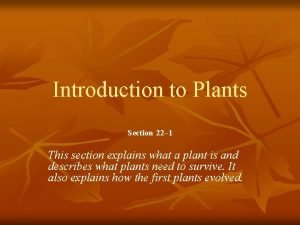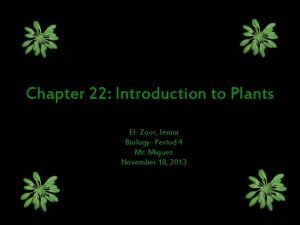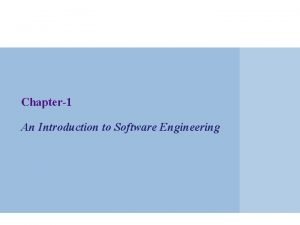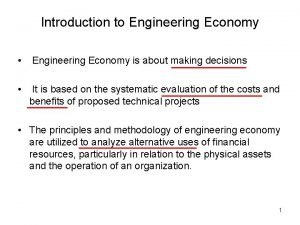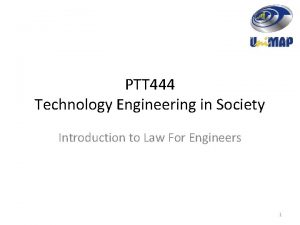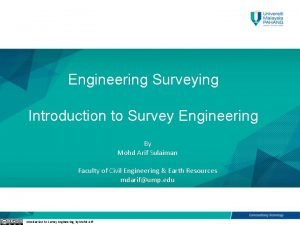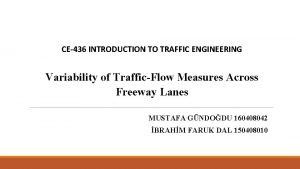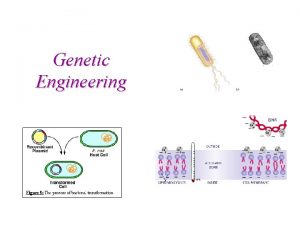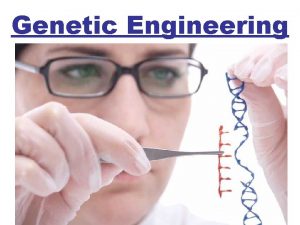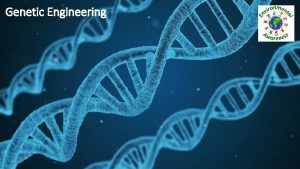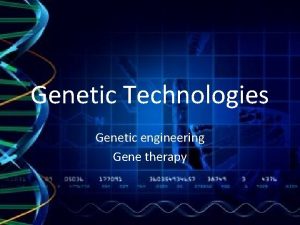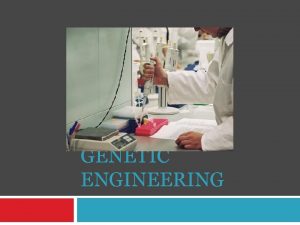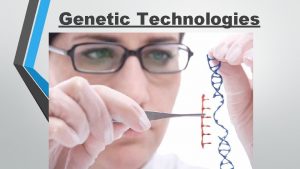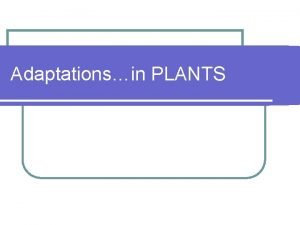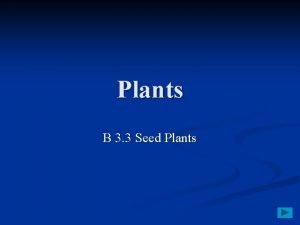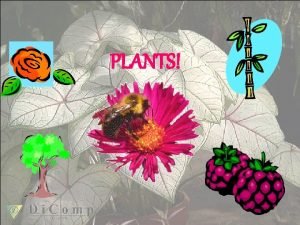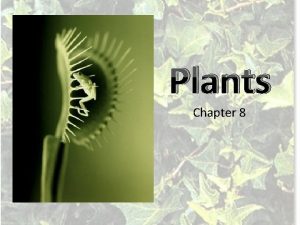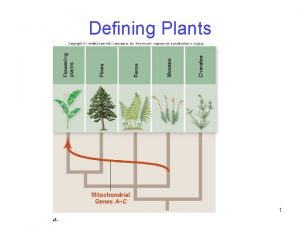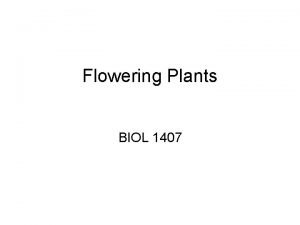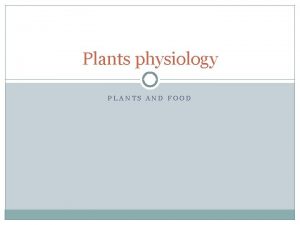AN INTRODUCTION TO GENETIC ENGINEERING IN PLANTS Genetic













































- Slides: 45

AN INTRODUCTION TO GENETIC ENGINEERING IN PLANTS

Genetic Engineering The process by which the genetic makeup of an organism can be altered using “recombinant DNA technology. ” Involving the use of laboratory tools to insert, alter, or cut out pieces of DNA that contain one or more genes of interest. Also called gene modification. Developing plant varieties expressing good agronomic characteristics is the ultimate goal of plant breeders.


Why not traditional breeding?

Comparison Conventional breeding Limited to exchanges between the same or very closely related species Little or no guarantee of any particular gene combination from the million of crosses generated Undesirable genes can be transferred along with desirable genes Takes a long time to achieve desired results Genetic engineering Allows the direct transfer of one or just a few genes, between either closely or distantly related organisms Crop improvement can be achieved in a shorter time compared to conventional breeding Allows plants to be modified by removing or switching off particular genes

Genetic engineering in crop production



PROCESSES INVOLVED IN GENETIC ENGINEERING & Transgenic Crops

What is a transgenic Plant “A transgenic plant is a plant with an insertion of DNA from another organism “

How to make a Transgenic Plant 1) 2) 3) 4) 5) Isolate DNA that codes for the gene of interest. Insert the DNA into Plasmid Insert the plasmid into Bacteria and grow the bacteria containing the plasmid. Dip the flowering plant into a large amount of bacteria. Give bacteria the opportunity to insert the DNA into plant cells.

Genetic Engineering

Genetic Engineering with Tissue Culture

Tissue Culture Technique

Transforming Plants Transformation is the heritable change in a cell or organism brought about by the uptake and establishment of introduced DNA. There are two main methods of transforming plant cells and tissues: The "Gene Gun" method (also known as micro-projectile bombardment or biolistics). This technique has been especially useful in transforming monocot species like corn and rice. The Agro-bacterium method, which is described below. Transformation via Agro-bacterium has been successfully practiced in di-cots (broadleaf plants like soybeans and tomatoes) for many years, but only recently has it been effective in monocots (grasses and their relatives). In general, the Agrobacterium method is considered preferable to the gene gun, because of the greater frequency of single-site insertions of the foreign DNA, making it easier to monitor.

Agro-bacterium and Gene Gun

WHAT IS TISSUE CULTURE AND TRANSGENESIS THROUGH TISSUE CULTURE

WHAT IS TISSUE CULTURE? “Tissue culture is a process that involves exposing plant tissue to a specific regimen of nutrients, hormones, and light under sterile, in vitro conditions to produce many new plants, each a clone of the original mother plant, over a very short period of time. ”


WHAT IS TRANSGENESIS? “Transgenesis is the process of introducing an exogenous gene — called a transgene — into a living organism so that the organism will exhibit a new property and transmit that property to its offspring. ”

PLANT TRANGENESIS AND TISSUE CULTURE A part of DNA with the desired characteristic is extracted and isolated from a foreign plant. This is then cloned and designed in such a form so that the plant is which it is inserted, accepts the new gene as its own gene. This new gene now has infiltrated in the genome of the new plant and its making the desired change. Once this plant starts to exhibit the new property, tissue of this plant is extracted and is then exposed to optimum conditions for tissue culturing. In this way, we get a large yield of plants bearing the desired qualit.


ADVANTAGES OF TRANSGENIC CROPS

CRISPR/CAS 9

• Originally discovered in Bacteria as an acquired defense against foreign pathogens. • CRISPR/Cas technology has been demonstrated to work successfully on all the common model organisms making it one of the hottest technological breakthroughs in 2013.

Two important elements: 1 - Homing Device (Guide RNA/ g. RNA) (20 nucleotide sequence) 2 -Endonuclease u(Cas 9 is an enzyme for introducing double stranded cleavage) u. PAM is sufficient to direct Cas 9 nuclease to the complementary side of the genome and create double strand break.

Compared to previous genome editing methods such as Zinc finger (ZFN) and TALEN Cheaper Quicker More Accessible

u. CRISPR/Cas based genome editing can be achieved with a simple transfection. u. Ori gene offers an all in one gene p. Cas-Guide engineered with all the essential elements with targeted cleavage.

Two types of editing are commonly used: u. Homologous Repair (the desired change is flanked by right/left arm sequences and upon double crossover desired change is integrated in the genome)

Non-Homologous end-joining repair (Ends of the breaks are joined together introducing random mutations)

u. You can generate Indel library at targeted locus. u. You can knock out a target gene and simultaneously knock in a functional cassette (mammalian selection marker/florescent marker)

You can introduce predesigned mutations.

Editing Plant Genomes With CRISPR/Cas 9

Nicotianabenthamian, Nicotianatabacum and Arabidopsis and crops, such as wheat, maize, rice, sorghum, tomato and sweet orange. A detailed protocol of targeted mutagenesis in rice and wheat using the CRISPR/Cas 9 system has also recently been published. CRISPR/Cas 9 also allows multiplex gene editing by the simultaneous expression of two or more sg. RNAs. This has been reported in Arabidopsis, rice and tomato. Deleting chromosomal fragments allows deletions of entire clusters of genes.



Business impact Participants in agriculture business markets include seed companies, agrochemical companies, distributors, farmers, grain elevators and universities that develop new crops/traits and whose agricultural extensions advise farmers on best practices. Syngenta and Du. Pont Pioneer are the next biggest companies in market.

Future Applications Transgenic crops include resistance to certain pests, diseases, or environmental conditions, reduction of spoilage, or resistance to chemical treatments (e. g. resistance to a herbicide), or improving the nutrient profile of the crop. Examples in non-food crops include production of pharmaceutical agents, biofuels, and other industrially useful goods, as well as for bioremediation.

Transgenic carrots have been used to produce the drug Taliglucerase alfa which is used to treat Gaucher's disease.

Plants have been engineered to exhibit bioluminescence that may become a sustainable alternative to electric lighting. Example : Flying and glowing firefly, Photinus pyralis.

In the laboratory, transgenic plants have been modified to increase photosynthesis (currently about 2% at most plants to theoretic potential of 9– 10%. This is possible by changing the rubisco enzyme (i. e. changing C 3 plants into C 4 plants), by placing the rubisco in a carboxysome, by adding CO 2 pumps in the cell wall, by changing the leaf form/size.

Cisgenic plants are made using genes found within the same species or a closely related one, where conventional plant breeding can occur. Some breeders and scientists argue that cisgenic modification is useful for plants that are difficult to crossbreed by conventional means (such as potatoes), and that plants in the cisgenic category should not require the same regulatory scrutiny as transgenics


Geneticallly modified food/crops can come out as a miracle for countries who are victims of drought. There are people who are food insecure, malnourished or starving because of drought. In areas like sub-Saharan Africa where poverty rates are high, farmers often find it difficult to recover from droughts, if they recover at all. By creating crops that are drought resistant, lives will certainly be saved.

Conclusion Whether countries allow genetically modified crops or not, it should still be a high priority to examine genetic engineering in more detail so a larger body of knowledge can be developed, and techniques can possibly be implemented on a wider scale.
 What is the difference between genetic drift and gene flow
What is the difference between genetic drift and gene flow Genetic programming vs genetic algorithm
Genetic programming vs genetic algorithm Genetic programming vs genetic algorithm
Genetic programming vs genetic algorithm Genetic drift vs genetic flow
Genetic drift vs genetic flow Genetic drift vs genetic flow
Genetic drift vs genetic flow Vascular vs nonvascular plants
Vascular vs nonvascular plants Non vascular vs vascular plants
Non vascular vs vascular plants Characteristics of flowering and non flowering plants
Characteristics of flowering and non flowering plants Photosynthesis equation
Photosynthesis equation Insulin bacteria genetic engineering
Insulin bacteria genetic engineering Section 13-1 changing the living world
Section 13-1 changing the living world Applications of genetic engineering
Applications of genetic engineering Cloning tasmanian tiger
Cloning tasmanian tiger Purpose of genetic engineering
Purpose of genetic engineering Genetic engineering conclusion
Genetic engineering conclusion Oryx and crake genetic engineering
Oryx and crake genetic engineering Genetic modification pros and cons in humans
Genetic modification pros and cons in humans Steps in genetic engineering
Steps in genetic engineering Bioluminescent genetic modification
Bioluminescent genetic modification Objectives of genetic engineering for class 10
Objectives of genetic engineering for class 10 Agrobacterium tumefaciens genetic engineering
Agrobacterium tumefaciens genetic engineering Genetic engineering
Genetic engineering Algenol
Algenol Cry gene
Cry gene Genetic engineering
Genetic engineering Grabber
Grabber Introduction to genetic analysis tenth edition
Introduction to genetic analysis tenth edition Section 22-1 introduction to plants answer key
Section 22-1 introduction to plants answer key Chapter 22 introduction to plants worksheet answers
Chapter 22 introduction to plants worksheet answers Computer based system engineering in software engineering
Computer based system engineering in software engineering Forward engineering in software engineering
Forward engineering in software engineering Principles of complex systems for systems engineering
Principles of complex systems for systems engineering Engineering elegant systems: theory of systems engineering
Engineering elegant systems: theory of systems engineering Forward and reverse engineering
Forward and reverse engineering Isometric drawing
Isometric drawing Introduction to civil engineering
Introduction to civil engineering Industrial engineering chapter
Industrial engineering chapter Introduction to software engineering
Introduction to software engineering Introduction to microwave engineering ppt
Introduction to microwave engineering ppt Introduction to web engineering
Introduction to web engineering Introduction to engineering economy
Introduction to engineering economy Introduction to engineering economics
Introduction to engineering economics Introduction to reliability engineering
Introduction to reliability engineering Ptt 444
Ptt 444 Engineering survey definition
Engineering survey definition Introduction to traffic engineering
Introduction to traffic engineering









